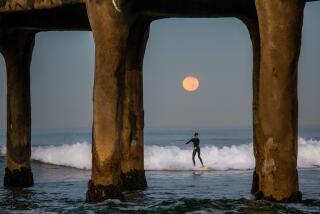Meteors, Eclipse Will Be Stars of Sky Show
- Share via
There will be something for everybody in the nighttime sky during the next few weeks, including a meteor shower this weekend and a total eclipse of the moon next week.
August will also bring the astronomical highlight of the year when the aging Voyager 2 spacecraft zips over the cloud tops of Neptune on the evening of Aug. 24. Even the most powerful telescopes on Earth will not be able to see the one-ton spacecraft as it visits the fourth and final planet on its “Grand Tour” of the outer solar system, but Voyager will beam back thousands of images and a warehouse full of scientific data to the Jet Propulsion Laboratory in Pasadena.
Also out of sight will be another, less spectacular event involving the smallest planet in the solar system. Pluto will prove that not only is it a bit puny, it is also a little tricky.
Fickle Orbit
On Sept. 5, Pluto will make its closest approach to the sun, called perihelion. The tiny planet will still be a long way away, about 2.7 billion miles to be exact, but the event will prove once again that Pluto can be a bit fickle. That is because the highly elliptical orbit that Pluto follows brings it inside the orbit of Neptune for perihelion, making it the eighth planet from the sun, not the ninth.
Neptune, which is awaiting the encounter with Voyager, is currently the most distant known planet in the solar system, and it will stay that way for several years until Pluto once again moves outside its orbit. Anyone who misses Pluto’s approach to the sun this time can catch it again in the year 2236.
While only those equipped with a very powerful telescope will be able to watch Pluto’s lonely voyage, everyone will have a chance to take part in the Perseids meteor shower Friday night and early Saturday morning.
There are at least 10 significant meteor showers each year, and the Perseids is the most prolific. It occurs each August when the Earth passes through the debris left behind by a comet known as Swift-Tuttle. The shower has been observed for 1,900 years, and in some years up to 100 meteors per hour have been seen entering the Earth’s atmosphere.
For years the Perseids were known as “the Tears of St. Lawrence” after a Spanish martyr who was killed close to the time of the shower in the year 258.
The meteors enter the Earth’s atmosphere at about 135,000 m.p.h., incinerating themselves as they plunge through the air.
Andrew Fraknoi, executive officer of the Astronomical Society of the Pacific, said observers should be able to see about 50 meteors per hour if they find an area removed somewhat from city lights so they have a clear view of the dark sky. He also recommends against using binoculars because any such instrument will narrow the field of view.
All that is necessary, he said, is to find a dark spot, let your eyes adjust to the darkness for about 15 minutes, and then lie back and enjoy the show.
The total lunar eclipse will occur next Wednesday, Aug. 16, when the Earth passes directly between the sun and the moon, capturing the moon in its shadow.
Those watching the event in California will have a slight problem in that the eclipse actually begins at 7:28 p.m., a few minutes before the sun sets so it will be hard to see it in the early minutes. However, the total eclipse will last until 8:56 p.m., so it will be dark long before the show ends.
As the eclipse ends, the moon will become more and more visible as it emerges from behind the Earth and into sunlight.
Shutterbugs should have no trouble capturing the event on film, weather permitting. Dennis Mammana, resident astronomer at the Reuben H. Fleet Science Center in San Diego noted that exposure settings for “shooting the moon” are the same as for any other object in full sunlight.
No Threat to Eyes
Unlike an eclipse of the sun, a lunar eclipse poses no threat to the eyes of observers on Earth.
There is yet another possibility in this smorgasbord of astronomical delights. The Space Shuttle Columbia was launched Tuesday on a secret military mission, reportedly carrying a spy satellite.
Normally, the shuttle follows an orbit that keeps it well south of California, but if the reports of its cargo are correct, it should have been launched into an orbit that will carry it to more than 50 degrees above the Equator. That would bring it over California repeatedly until it ends its five-day mission at Edwards Air Force Base.
This being a secret mission, there is no way of knowing when the shuttle will pass over California, but anyone who sees a faint light rising in the east and zipping to the western horizon in about three minutes should be advised that was no meteor.






